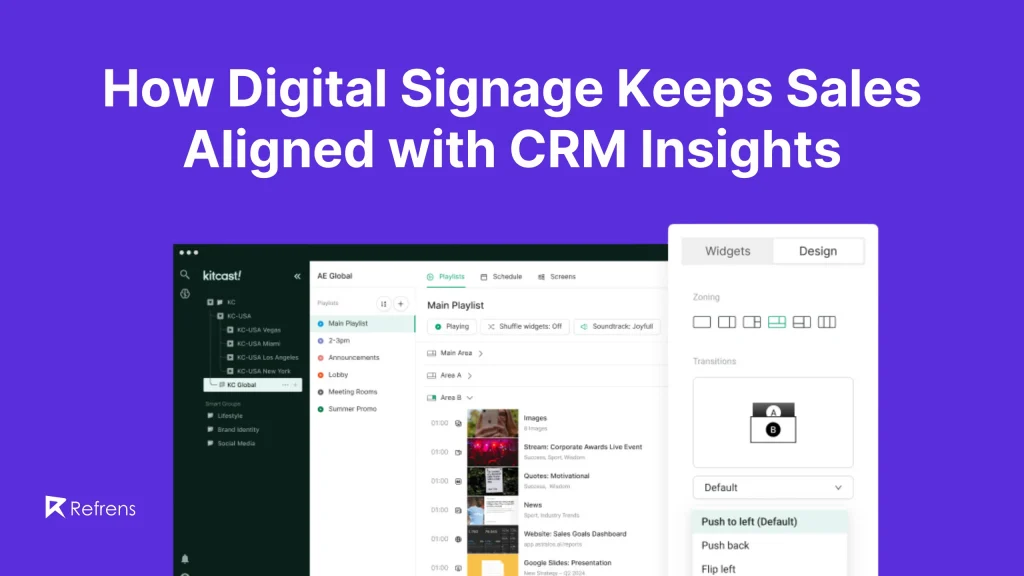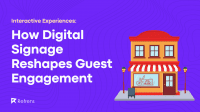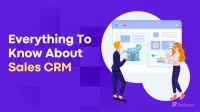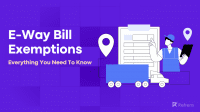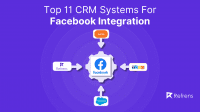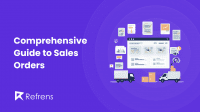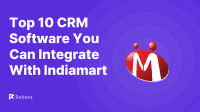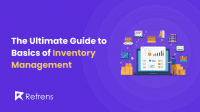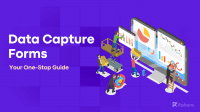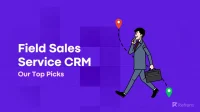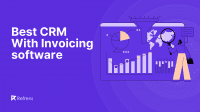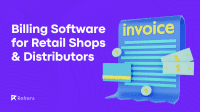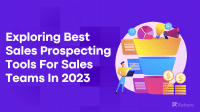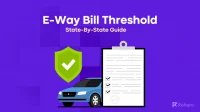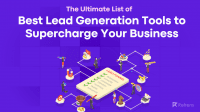Salespeople’s practices prove: selling is about listening, not talking. In fact, it’s about watching – tracking data. According to McKinsey’s insights, 53% of the companies that grow at a swift rate emphasize data analytics as a drastically effective tool for high performance.
Here is where CRM systems come into play. They provide a vivid picture of all customers, prospects, and their data, from entering the funnel to their current position in the pipeline. The next level – a CRM paired with digital signage. It’s the escape from digging through tons of this information. Just glance at the display and see instantly where things stand.
Information overload: why it’s hard for a sales rep to filter through it
Information overload is the dark side of CRM systems. Salespeople are flooded with data. Whether a team uses Salesforce, HubSpot, or another solution, they need to navigate through it in any way to obtain information.
Typically, CRMs include 20-40 tabs. The most common tabs are leads, contacts, accounts, pipeline information, campaigns, and reports. Sales usually sift through several layers to get the data on the surface.
The lack of real-time visibility delays actions – sales. A high-value lead may sit in the pipeline, but remain unnoticed. It also results in chaotic processes inside the team. Sales reps focus everyone on their own prospects without seeing the overall progress.
For business, it means stagnation in sales and revenue decline.
Plus, CRM data, when it’s viewed as raw material – unorganized numbers and lists – doesn’t inspire actions. It doesn’t provide a bigger picture. A sales team needs to process it first to make the right decisions.
Digital signage translates data into what the human brain perceives in the best possible way – visuals.
360-degree CRM data view with digital signage
Digital signage reshapes how salespeople see the data extracted from CRMs. It shows information here and now, without opening dozens of tabs. This approach minimizes the lag between getting information and acting on it.
The power of digital displays is visualization. As 90% of the information our brain acquires is from sight, this inherently visual solution makes data consumption much faster. Sales reps see it in front of them and interpret it for insights-driven actions instantly.
Data translated from a CRM to screens gets team-wide visibility. On top of that, if sales need an all-around perspective and focus on several key metrics, enterprise digital signage providers like Kitcast offer a zoning feature. You can virtually divide a screen into multiple sectors with each featuring its own content. For example, if you need customer satisfaction scores displayed together with segmentation and prioritization, you get it in one place.
Examples of CRM insights delivered via digital signage
From graphs and leaderboards to pipeline stages, digital signage can align salespeople with any type of CRM insights.
- Real-Time Leads Progressing
Let everyone from the team know the leads’ statuses. Show the number of people under stages like Prospect, Qualified Lead, Proposal, Closed Deal. E.g. “Qualified Lead: 6, Closed Deal: 2, Pipeline Value: $110,000.”
- CRM Data Alerts
Notify salespeople about closed or failed deals. Automated announcements of wins and fails pulled from a CRM motivate employees and push them to strive for more.
- Lead Conversions
Connect digital signage to lead management software and send lead conversion rates to screens. Keep track of how many prospects became customers and who in your sales team has the highest metrics.
- Client Segmentation
Display customer groups on screens for sales to focus on top-tier clients and highlight segments requiring more attention.
Example: “High-value clients ($50K+): 8 open deals. Not contacted this week: 3.”
- Customer Satisfaction Data
Show Output Customer Satisfaction Score (CSAT) and Net Promoter Scores (NPS) and monitor the level of client satisfaction.
- Sales Performance Across Regions
Display CRM data segmented by specific region. It allows salespeople to see high-performing and low-performing geolocations and take measures to improve KPIs.
- Daily/Weekly/Monthly Reports
Any strategy can’t be implemented without reporting. Send reports from a CRM to screens to stimulate data-driven actions. Use digital signage software like Kitcast that provides tools for content scheduling. Just choose dates for reporting in the calendar and set it to automatically appear on screens.
How digital signage makes an impact teaming up with CRM
Think about the digital displays plus a CRM duo as a backend and frontend. The backend is a very important part where information is kept and processed. However, without the frontend, it doesn’t make much sense. Delivering data right to its users to propel progress is what matters most for a business.
Digital signage complements the value of CRM systems and prospecting tools. They’re packed with tons of beneficial insights, but not every sales rep has enough time to sort through it all. Data put on a big screen becomes more easy to grasp.
Sales hinge on data. This is how digital signage transforms sales’ performance making data visible to them.
- Overall Team Performance Improvement
Salespeople have a competitive mindset. It’s a motivation factor that lies in the nature of sales. Showing the number of successful deals on digital signage triggers everyone’s desire to lead this ranking. It creates a goal-oriented working environment.
- Efforts, Prioritized Right
Let’s say you have 3 categories of accounts: tier-one (generates the most revenue), tier-two, and tier-three. They aren’t equal as they may be at different stages of the buying journey and differ based on financial interest. CRM data displayed on screens can draw attention to the group with the highest value. For example, you see that the customer from the tier-one segment interacted with a new product but didn’t complete the purchase. With alerts placed on screens, a salesperson can shift focus to a more high-profitable customer, so they finish a buying cycle.
- Insight-Led Strategies
The best sales CRMs are those that grow sales volume. The integration with digital signage can make strategies for sales growth smarter. Displaying data on screens allows sales reps to notice trends immediately and capitalize on them. Does a certain product consistently outperform others? Do specific customers respond better to campaigns? Let insights do the talking.
- More Opportunities for Upselling and Cross-Selling
CRM systems are a goldmine of opportunities when noticed. Client data shows important patterns. If they’re observed on time, it gives salespeople a solid bedrock to pitch additional products and services.
- Churn Rate Cutdown
Acquisition is important, but retention outperforms it in benefits. Loyal customers spend x3 more than single-purchase customers. Moreover, to acquire new clients costs more. The tandem of a CRM and digital signage allows to cut churn rates capitalizing on data and improve retention metrics. Spot at-risk customers – let screens show visual alerts or highlight customers who require attention. View client profiles and insights in real time to anticipate their needs and keep them on board.
How to get a CRM + digital signage combo?
Digital signage acts as an information bridge that takes data from a CRM and translates it to screens. The core behind this connection is an API (Application Programming Interface). Its task is to pull data stored in a CRM and send it to a display.
The process of connecting an API with a CRM includes the following steps:
- CRM provides data via its API. The access authentication is based on a kind of “key”. It ensures that the one requesting CRM data is an authorized user.
- The system makes GET requests to the CRM API to get data (e.g., sales performance, leads, or client info).
- The next step is data processing. It’s formatted in a way to fit screens.
- Once data is processed and ready, it’s delivered to displays. Here, the POST requests do their part. The information is shown on screens via a digital signage API.
- The main point of this connection is constant updates, so a sales team gets fresh information. For information renewal, developers set intervals or use webhooks.
What’s great about an API is that, once integrated, there’s no need for manual updates. The information is featured on screens updating automatically.
Every CRM is different. From open-source lead management software to hybrid solutions, the “inner world” of technical specifications varies drastically. That’s why digital signage providers with flexible APIs win the game. Given the fact that customer relationship software can be based on diverse data structures and endpoints, a rigid API works best. Signage solutions with flexible APIs, like Kitcast, see the value in custom integrations. That’s why they use an agile approach that guarantees faster deployments.
Indeed, it’s not feasible for sales reps to grasp and process tons of data a CRM holds in its storage. However, with simplified, visual representation, complex data turns into clearly laid out dashboards, charts, and graphs.
For sales teams, it means making room for proactive sales. It results in more deals closed, more profits secured. Staying aligned with what is happening with a customer base in a well-arranged way allows sales reps to be laser-focused on goals and accomplish them. At the end of the day, sales are nothing but the art of reading data between the lines and making the right moves at the right time.
